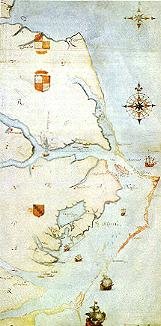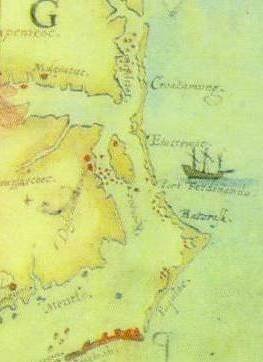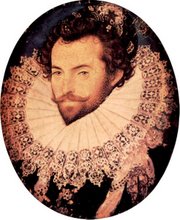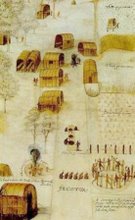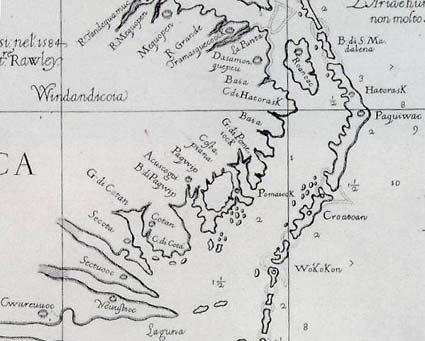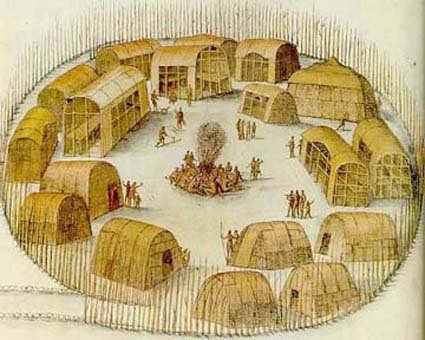
The Roanoke Colony on Roanoke Island in Dare County in present-day North Carolina was an enterprise financed and organized by Sir Walter Raleigh in the late 16th century to establish a permanent English settlement in the Virginia Colony. Between 1585 and 1587, groups of colonists were left to make the attempt, all of which either abandoned the colony or disappeared. The final group disappeared after a period of three years elapsed without supplies from England, leading to the continuing mystery known as "The Lost Colony." The principal hypothesis is that the colonists disappeared and were absorbed by one of the local indigenous populations, although the colonists may possibly have been massacred by the Spanish. Other theories include a massacre by some of the hostile local tribes.
 Sir Walter Raleigh had received a charter for the colonization of the area of North America known as Virginia from Queen Elizabeth I of England. The charter specified that Raleigh had ten years in which to establish a settlement in North America or lose his right to colonization.
Sir Walter Raleigh had received a charter for the colonization of the area of North America known as Virginia from Queen Elizabeth I of England. The charter specified that Raleigh had ten years in which to establish a settlement in North America or lose his right to colonization.
Raleigh and Elizabeth intended that the venture should provide riches from the New World, and a base from which to send privateers on raids against the treasure fleets of Spain.
In 1584, Raleigh dispatched an expedition to explore the eastern coast of North America for an appropriate location. The expedition was led by Phillip Amadas and Arthur Barlowe, who chose the Outer Banks of modern North Carolina as an ideal location from which to raid the Spanish, who had settlements to the South, and proceeded to make contact with local American Indians, the Croatan tribe of the Carolina Algonquians.
First Group
The following spring, a colonizing expedition composed solely of men, many of them veteran soldiers who had fought to establish English rule in Ireland, was sent to establish the colony. The leader of the settlement effort, Sir Richard Grenville, was assigned to further explore the area, establish the colony, and return to England with news of the venture's success. The establishment of the colony was initially postponed, perhaps because most of the colony's food stores were ruined when the lead ship struck a shoal upon arrival at the Outer Banks. After the initial exploration of the mainland coast and the native settlements located there, the natives in the village of Aquascogoc were blamed for stealing a silver cup. In response the last village visited was sacked and burned, and its weroance (tribal chief) executed by burning. Despite this incident and a lack of food, Grenville decided to leave Ralph Lane and approximately 75 men to establish the English colony at the north end of Roanoke Island, promising to return in April 1586 with more men and fresh supplies.
By April 1586, relations with a neighboring tribe had degraded to such a degree that they attacked an expedition led by Lane to explore the Roanoke River and the possibility of the Fountain of Youth. In response he attacked the natives in their capital, where he killed their weroance, Wingina.
As April passed there was no sign of Grenville's relief fleet. The colony was still in existence in June when Sir Francis Drake paused on his way home from a successful raid in the Caribbean, and offered to take the colonists back to England, an offer they accepted. The relief fleet arrived shortly after the departure of Drake's fleet with the colonists. Finding the colony abandoned, Grenville decided to return to England with the bulk of his force, leaving behind a small detachment both to maintain an English presence and to protect Raleigh's claim to Virginia.
Second group
In 1587, Raleigh dispatched another group of colonists. These 121 colonists were led by John White, an artist and friend of Raleigh's who had accompanied the previous expeditions to Roanoke. The new colonists were tasked with picking up the fifteen men left at Roanoke and settling farther north, in the Chesapeake Bay area; however, no trace of them was found, other than the bones of a single man. The one local tribe still friendly towards the English, the Croatans on present-day Hatteras Island, reported that the men had been attacked, but that nine had survived and sailed up the coast in their boat.
The settlers landed on Roanoke Island on July 22 1587. On August 18, White's daughter delivered the first English child born in the Americas: Virginia Dare. Before her birth, White reestablished relations with the neighboring Croatans and tried to reestablish relations with the tribes that Ralph Lane had attacked a year previously. The aggrieved tribes refused to meet with the new colonists. Shortly thereafter, George Howe was killed by natives while searching for crabs alone in Albemarle Sound. Knowing what had happened during Ralph Lane's tenure in the area and fearing for their lives, the colonists convinced Governor White to return to England to explain the colony's situation and ask for help. There were approximately 116 colonists—115 men and women who made the trans-Atlantic passage and a newborn baby, Virginia Dare, when White returned to England.
Crossing the Atlantic as late in the year as White did was a considerable risk, as evidenced by the claim of pilot Simon Fernandez that their vessel barely made it back to England. Plans for a relief fleet were initially delayed by the captains' refusal to sail back during the winter. Then, the coming of the Spanish Armada led to every able ship in England being commandeered to fight, which left White with no seaworthy vessels with which to return to Roanoke. He did manage, however, to hire two smaller vessels deemed unnecessary for the Armada defense and set out for Roanoke in the spring of 1588. This time, White's attempt to return to Roanoke was foiled by human nature and circumstance; the two vessels were small, and their captains greedy. They attempted to capture several vessels on the outward-bound voyage to improve the profitability of their venture, until they were captured themselves and their cargo taken. With nothing left to deliver to the colonists, the ships returned to England.
Because of the continuing war with Spain, White was not able to raise another resupply attempt for two more years. He finally gained passage on a privateering expedition that agreed to stop off at Roanoke on the way back from the Caribbean. White landed on August 18, 1590, on his granddaughter's third birthday, but found the settlement deserted. He organized a search, but his men could not find any trace of the colonists. Some ninety men, seventeen women, and eleven children had disappeared; there was no sign of a struggle or battle of any kind. The only clue was the word "Croatoan" carved into a post of the fort and "Cro" carved into a nearby tree. In addition, there were two skeletons buried. All the houses and fortifications were dismantled. Before the colony disappeared, White established that if anything happened to them they would carve a maltese cross on a tree near their location indicating that their disappearance could have been forced. White took this to mean that they had moved to Croatoan Island, but he was unable to conduct a search; a massive storm was brewing and his men refused to go any further. The next day, White stood on the deck of his ship and watched, helplessly, as they left Roanoke Island.
Full Article Here:
http://en.wikipedia.org/wiki/Roanoke_Colony







